CHAPTER 3: 12 GUIDING PRINCIPLES TO CHANGE YOUR LIFE
To expect a personality to survive the disintegration of the brain is like expecting a cricket club to survive when all of its members are dead.
BERTRAND RUSSELL
Our clinical and brain imaging work has led us to 12 simple principles that underlie all we do. I’ve written about these principles in depth in several of my books, including Change Your Brain, Change Your Life.[95] If you embrace them, they will set a foundation for brain health —and start to change everything in your life.
- 1. Your brain is involved in everything you do. How you think, how you feel, how you act, and how well you get along with other people has to do with the moment-by-moment functioning of your brain. Your brain is involved in every decision you make.
- 2. When your brain works right, you work right. When your brain is troubled, you have trouble in your life. When your brain is healthy, you tend to be effective, thoughtful, creative, and energetic. When your brain is troubled —for whatever reason —you are much more likely to have problems in your life, including issues with depression, anxiety, impulsivity, anger, inflexibility, and memory. Brain dysfunction, even when subtle, gets in the way of your ability to be successful in your relationships, your work, and even your finances.
- 3. Your brain is the most complicated organ in the universe. With about 100 billion neurons (nerve cells) and about another 100 billion support cells, your brain has more connections than there are stars in the universe. Your brain accounts for only 2 percent of your body’s weight, yet it uses 20 to 30 percent of the calories you consume and 20 percent of the oxygen and blood flow in your body.
- 4. Your brain has needs that must be met in order to work at optimal efficiency. The requirements for optimal brain function include:
- Healthy blood flow (to deliver oxygen, vitamins, and essential minerals to the brain)
- Proper hydration
- Physical and mental exercise
- Stimulation (new learning)
- Fuel (aka food)
- Hormones
- A strong (but not too strong) immune system
- An efficient waste management system
- Adequate sleep
- Meaning and purpose in your life
- Being socially connected to other brains
- 5. Your brain is soft, and it is housed in a very hard skull. Your brain is about the consistency of soft butter, and it floats inside your head in a bath of cerebrospinal fluid. Inside your skull, there are sharp bony ridges that can easily damage your brain. You must protect it.
- 6. Many things can hurt the brain. It is critical for you to know what hurts the brain (the BRIGHT MINDS risk factors will be discussed in part 2). A colored version of the poster on the right hangs in more than 100,000 schools, prisons, and therapist’s offices around the world as a reminder of this principle.
- 7. Many things can help the brain. It is critical for you to know what enhances the brain (see the BRIGHT MINDS interventions in part 2).
Many things both hurt and help the brain. It is critical for you to know the BRIGHT MINDS risk factors and interventions.
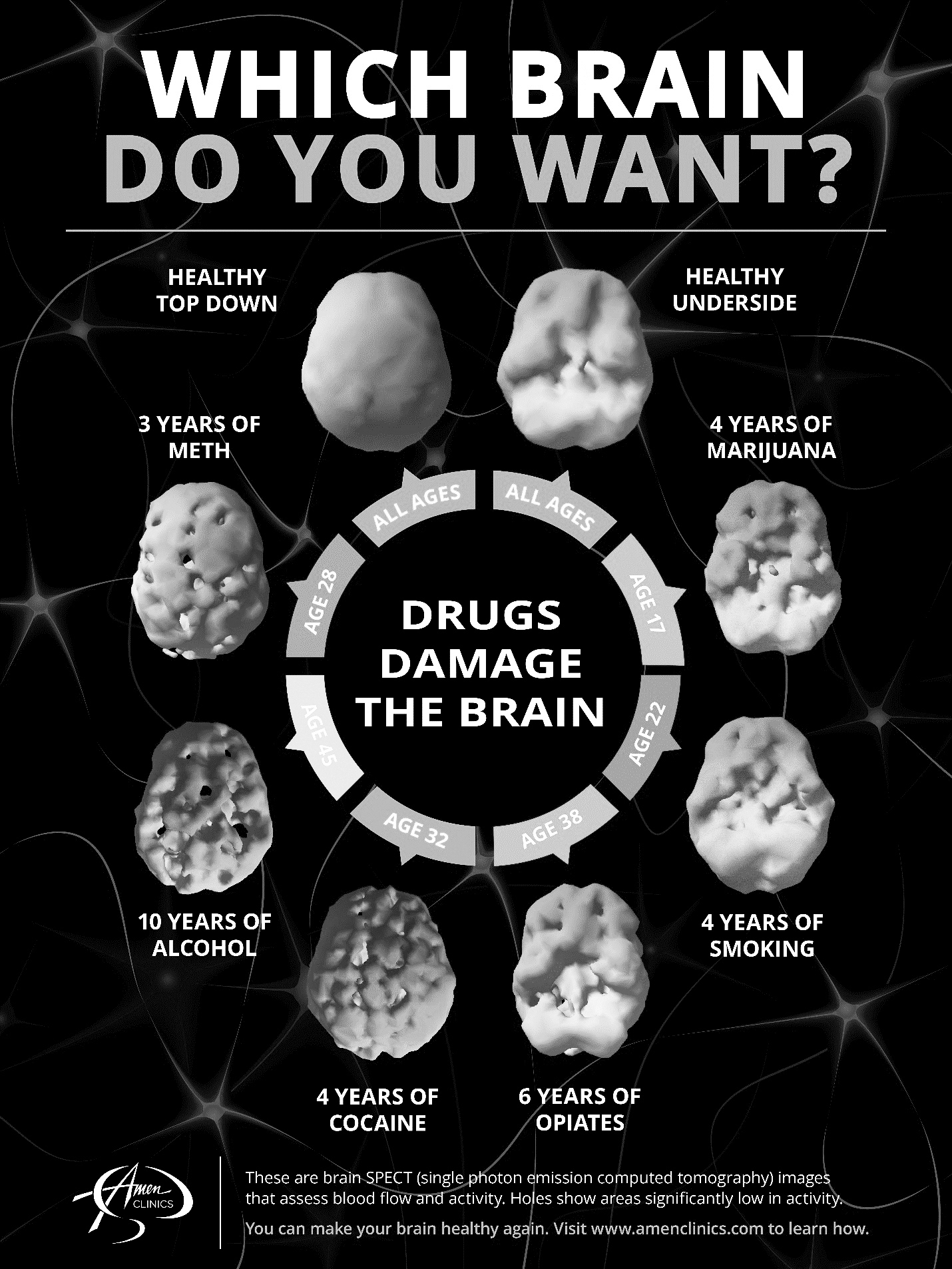
- 8. Like an orchestra, all parts of your brain need to be working well together to make you the best that you can be. Certain brain systems tend to do specific things. For example:
- Prefrontal cortex (PFC) —language, focus, forethought, judgment, empathy, impulse control, and learning from mistakes. This is called the executive brain because it is like the boss at work and helps you plan and make good decisions.
- Temporal lobes —visual and auditory processing, memory, learning, mood stability, and emotional reactiveness
- On the inside of the temporal lobes are two critically important structures: the hippocampus, involved with mood and memory; and the amygdala, involved with signaling fear, emotional reactions, and anxiety.
- The hippocampus is one of the few parts of your brain that continues to make new neurons every day. If you put it in a healing environment, it can grow bigger. If it comes under toxic attack or sustained stress, it can be easily damaged.
- Parietal lobes —direction sense, math, and constructing
- Occipital lobes —visual processing
- Cerebellum —physical, emotional, and cognitive coordination and processing speed. It houses half of the brain’s neurons, even though it makes up only 10 percent of the brain’s volume. It is one of the most underrated parts of the brain. I call it the “Rodney Dangerfield” part of the brain, because it gets little respect.
- Anterior cingulate cortex —shifting attention and error detection
- Basal ganglia —pleasure, motivation and adjusting movements
- Deep limbic system —sensory gating and emotional processing
None of these areas of your brain work in isolation.
- 9. Understanding your brain helps you identify specific problems and which part of your brain may need help. Problems in certain brain systems tend to be associated with specific issues, such as:
- PFC —language problems, short attention span, distractibility, a lack of planning and forethought, poor judgment, low empathy, poor impulse control, and not learning from mistakes
- Temporal lobes —visual and auditory abnormalities, poor memory, learning disabilities, mood instability, and temper issues
- Parietal lobes —poor direction sense and trouble with math
- Occipital lobes —visual processing issues
- Cerebellum —problems with physical, emotional, and thought coordination and processing speed
- Anterior cingulate cortex —trouble shifting attention, worry, holding grudges, obsessions, and excessive error detection
- Basal ganglia —addictions, tremors, and low motivation
- Deep limbic system —sensory overload, sadness, and negativity
Your Brain: A Brief Primer
YOUR BRAIN: A BRIEF PRIMER
Outside View of the Brain
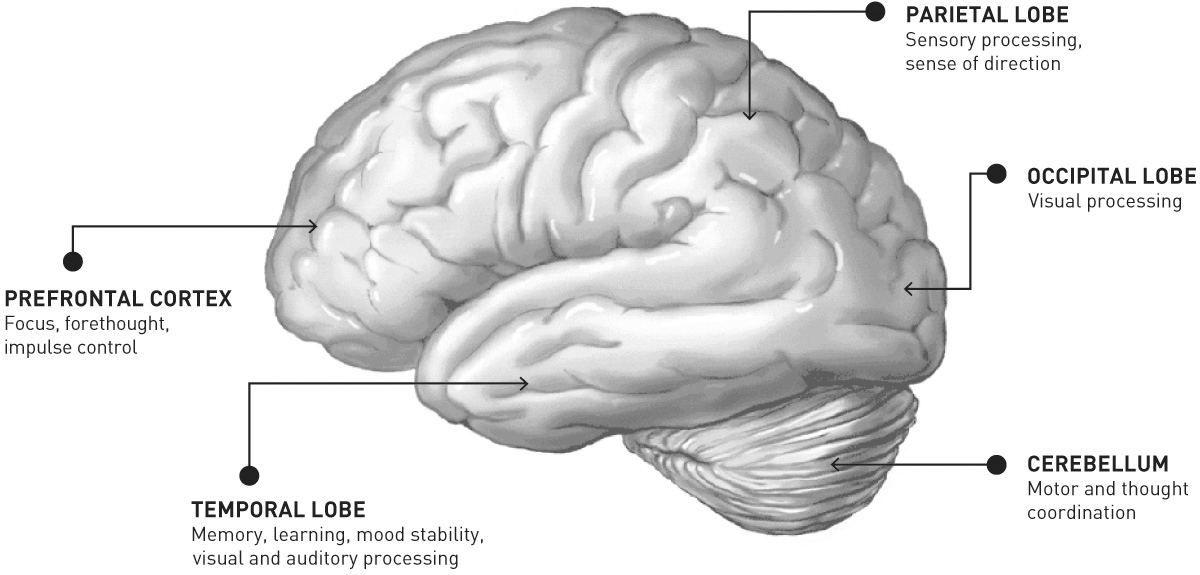
Inside View of the Brain
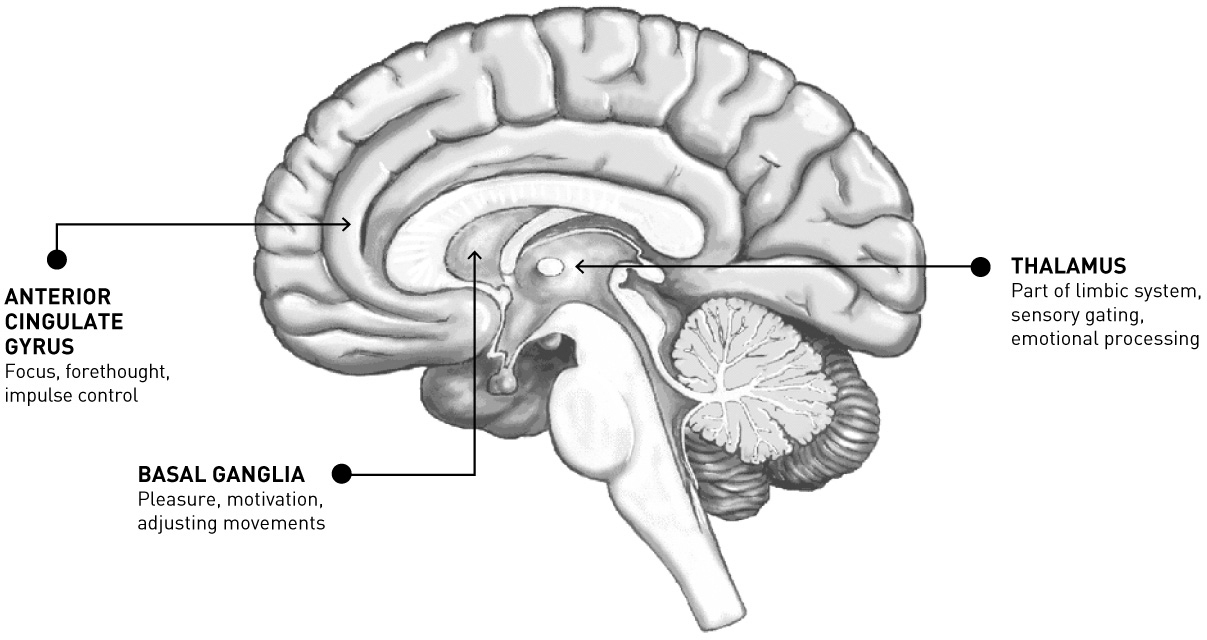
- 10. Psychiatric “illnesses” are not single or simple disorders; they all have multiple types that require their own treatments. Taking a one-size-fits-all approach to treatment invites repeated failure and frustration. Depression, for example, is a symptom, not an illness. I’ve written books on:
- Seven types of anxiety and depression (Healing Anxiety and Depression)
- Seven types of ADD/ADHD (Healing ADD)
- Six types of addicts (Unchain Your Brain)
- Five types of overeaters (Change Your Brain, Change Your Body)
Psychiatric illnesses are not single or simple disorders; they all have multiple types that require their own specific treatment strategies. Taking a one-size-fits-all approach to treatment invites failure and frustration.
- 11. The amount of “brain reserve” you have can help you handle life’s stresses or make you more vulnerable to them. Did you know that the adult brain loses an average of about 85,000 neurons a day? In early childhood, the brain is very active, sprouting new neurons and developing new connections between synapses. Older adults have significantly less activity in the brain. As we get older, our muscles tend to wither, and a similar process takes place in the brain. What we have learned from our brain imaging work is that your day-to-day lifestyle and activities are either accelerating or slowing the brain aging process. Just as you can train your muscles to retain a more youthful tone, you can use strategies to keep your brain functioning more optimally. Ultimately, brain aging is optional if you consistently use the right strategies.
When I talk to my patients about brain aging, I find it helpful to introduce them to the concept of “brain reserve.” That’s the extra cushion of brain function you have to help you deal with the stresses life throws at you. In general, the more brain reserve you have, the more resilient you are and the better your brain can handle the aging process to keep “mental health” disorders at bay. To illustrate this point to my patients, I typically show them the following “brain reserve” drawing. It shows the intersection of brain activity and age and habits. As you can see, at a certain point along the line in the graph, you cross a threshold indicating that your reserve is gone. This is when symptoms like anxiety, depression, memory problems, or temper flare-ups can appear.
Today marks one year since our first visit at Amen Clinics. My husband and I are forever grateful for you. My shame has been lifted and my mind renewed! I cannot imagine taking on this new position a year ago, thankful for how far I’ve come!
MEL E.
Brain Reserve
BRAIN RESERVE
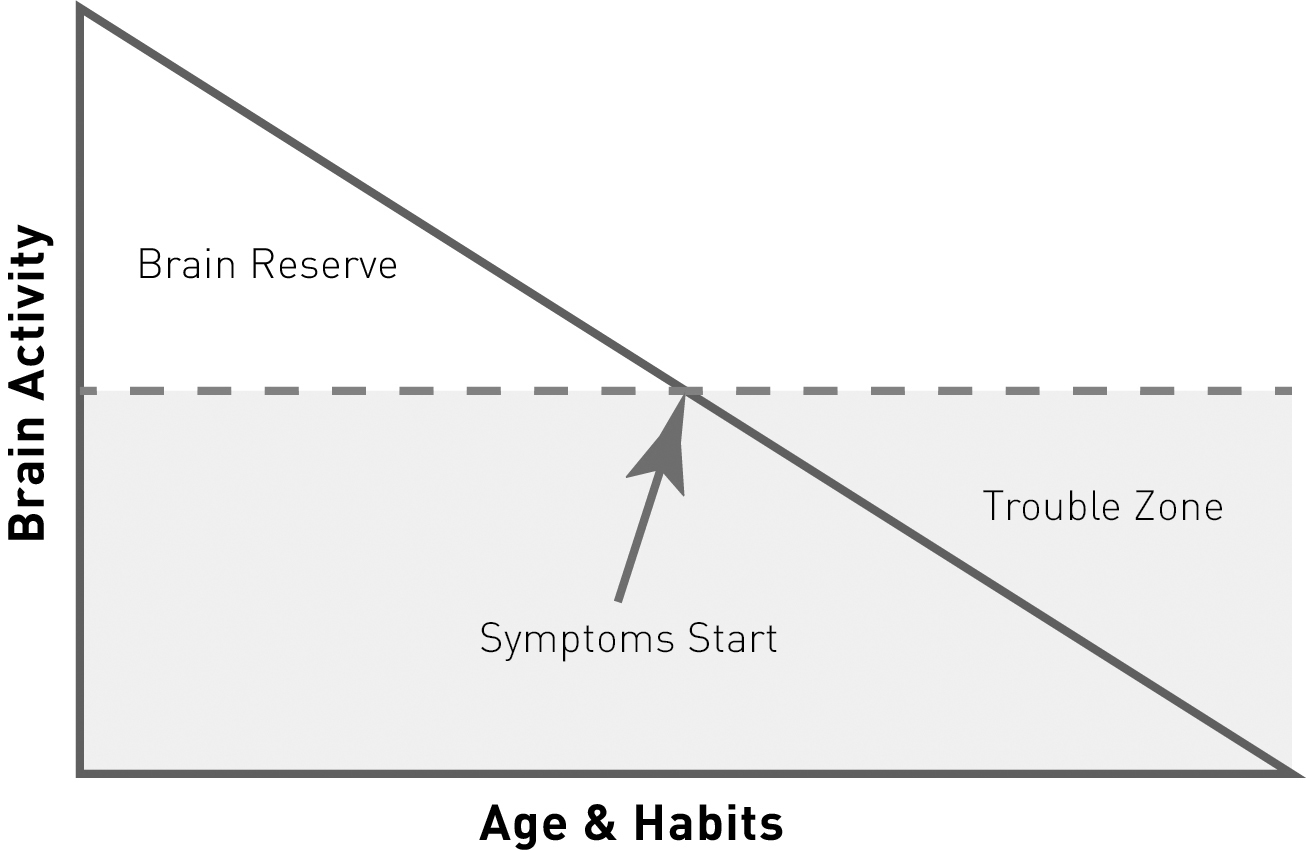
Let’s backtrack a bit to explain why some people have more brain reserve than others. A growing body of science is showing that even before you were conceived, your parents’ lifestyle habits were laying the foundation for your overall wellbeing and physical and mental health.[96] At conception, your brain had a certain potential for reserve. However, if your mom smoked (or got second-hand smoke from your dad), drank too much alcohol, ate junk food, was chronically stressed, or had infections during the pregnancy, it depleted your reserve —even before you were born. If, on the other hand, your mom (and dad) didn’t smoke, and she was healthy, ate nutritious meals, took prenatal vitamins, and was not overly stressed, it was contributing to a boost in your reserve.
After your grand entrance to the world, this increase or depletion in your brain reserve continues for the rest of your life. For example, if you were exposed to chronic stress or you witnessed domestic abuse at home, it decreased your reserve. If you fell off your bike and hit your head when you were in grade school, it lowered your reserve, even if you didn’t have any symptoms. If you started smoking marijuana as a teenager, it further depleted your reserve. Then if you played tackle football or hit a lot of soccer balls with your head, it took an additional toll on your reserve. Despite all of these knocks on your reserve, you may not have developed any symptoms . . . yet.
Here’s an example I like to use with my patients. Imagine two soldiers in a war-torn region. They are both in the same tank and exposed to the same blast injury at the same angles. They both survive the blast without physical injuries, yet one of them is subsequently racked by post-traumatic stress disorder (PTSD) and depression, while the other one experiences no residual mental health problems. Why? Luck? Probably not. It is far more likely that the two soldiers had different levels of brain reserve going into the accident. One soldier had more reserve because he took good care of his brain, he had lots of educational opportunities, his parents fed him well, and they didn’t let him play football. The other soldier had less reserve due to an unstable home environment, three previous concussions from playing football, a junk-food diet, and drug use as a teenager. They were both effective at their jobs, but they started at different places in terms of reserve. And even though the blast diminished both of their reserves, the one with more reserve avoided any mental health consequences while the one with less reserve crossed that threshold I mentioned earlier where the reserve is gone, making him vulnerable to brain health/mental health problems like PTSD and depression.
Why Trauma Leaves Some People, but Not Others, with “Mental Health” Problems
WHY TRAUMA LEAVES SOME PEOPLE, BUT NOT OTHERS, WITH “MENTAL HEALTH” PROBLEMS
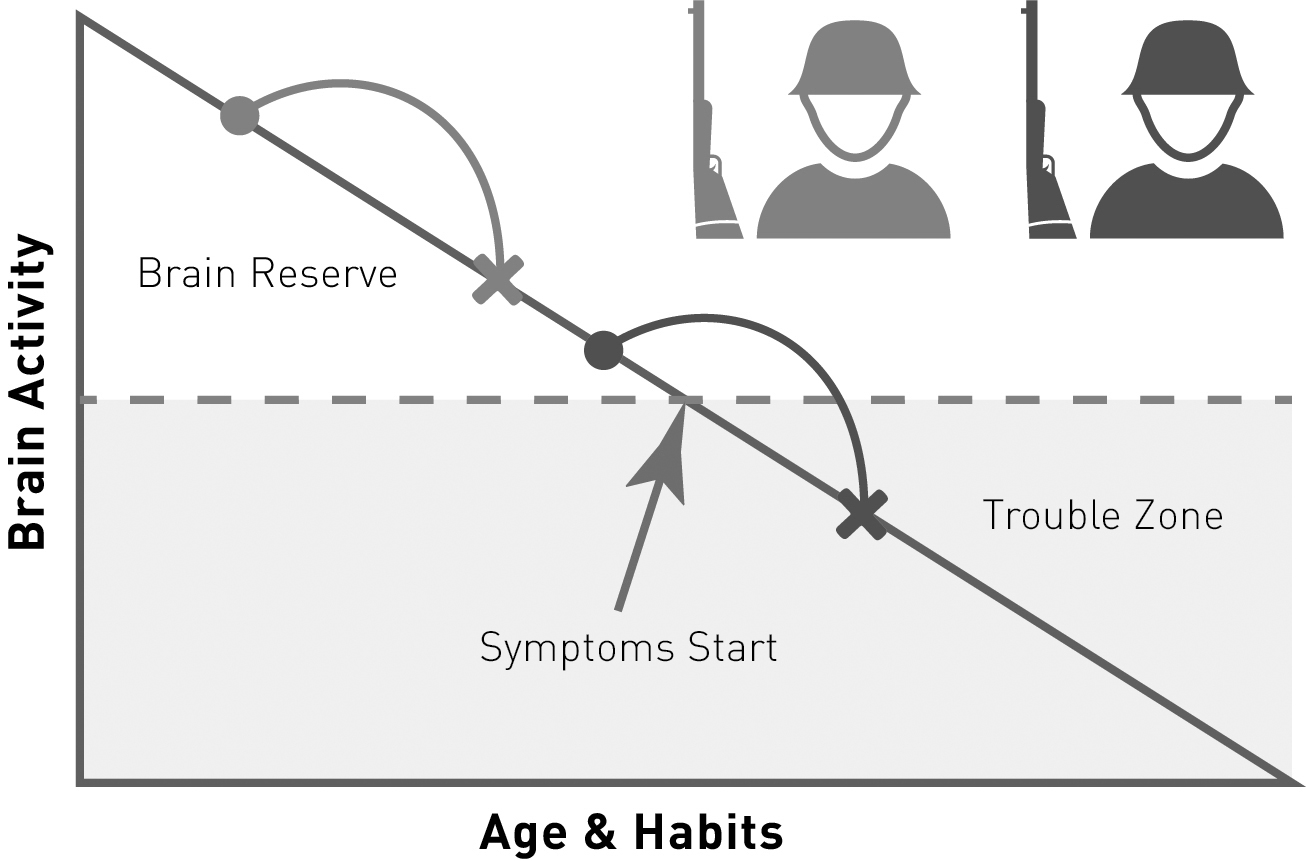
At Amen Clinics, most of the people we see are already symptomatic, which means they have crossed the brain reserve threshold (the dotted line in the previous two illustrations). Getting well is not just about eliminating the symptoms of “mental illness”; it’s also about increasing brain reserve to get it back above the line. To boost your brain reserve, you need to follow three simple strategies:
- Love your brain (you have to really care about your brain).
- Avoid the things that hurt your brain.
- Do the things that help your brain.
The decisions you make and the habits you engage in on a daily basis are either boosting or stealing your brain’s reserve and are either accelerating the aging process or rejuvenating your brain. When you grasp this concept, you realize that you have a lot of influence on the health and age of your brain, as well as on your own mental health and ability to end “mental illness.”
- 12. The most important lesson from imaging is that you are not stuck with the brain you have. You can make it better, and we can prove it. This is perhaps the most exciting and hopeful lesson we’ve learned. We all need to work hard to improve how our brains function because, with a better brain, a better life and better mental health always come.
The most exciting lesson learned from nearly 160,000 brain SPECT scans is that you can change your brain, change your life, and change your mental health . . . and I can prove it.
THE 12 GUIDING PRINCIPLES AND “MENTAL ILLNESS”
When you grasp the concepts of the 12 guiding principles, it becomes increasingly clear that mental health problems are, in fact, brain health problems. And it makes even more sense that eliminating brain health/mental health disorders involves optimizing brain function and boosting brain reserve. You’ll discover the interventions to help you do it in the rest of the book. I understand that you may be in a hurry to start putting these strategies into practice in your own life, but I urge you not to skip ahead. It’s very important to understand why you need to take a comprehensive approach to healing. Then you’ll have a stronger foundation to make the strategies in part 2 even more effective for you.